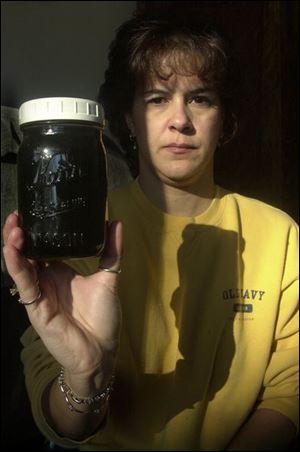
Tests show water is potable, but fight's on for city service
12/27/2000
Vickie Wilkins of Lambertville, Mich., displays dirty water she removed from one of her filters. She said she is eight signatures short of the number needed to ask for city water.
LAMBERTVILLE - A Toledo environmental testing lab and the Monroe County Health Department have determined that the smelly water coming from wells in the area of Summerfield and Consear roads is hard but safe to drink.
Still, Vickie Wilkins, who lives in the area that has been plagued with bad water, said she is just a handful of signatures short of the number required to bring city water to her neighborhood.
“I'm still about eight signatures short of the 51 percent we need, but hopefully we're going to re-contact some people to see if they'll change their minds,” Mrs. Wilkins said. “Nearly everybody seems to want city water. A lot of people are just hesitant to sign the petition” because it obligates them to pay a portion of the engineering fees if something goes wrong, she said.
The township board agreed last month to pay about $500 to have samples from six wells in an area bordered by Summerfield, Consear, Chamberlain, and Knepper roads tested by Jones & Henry Laboratories, Inc., in Toledo after residents brought samples of their smelly, discolored water to the township hall.
The firm tested for elevated concentrations of calcium, copper, iron, and magnesium, and forwarded their results to the environmental health division of the Monroe County Health Department.
The health department determined that the levels did not pose an immediate health risk, township supervisor LaMar Frederick said.
Mrs. Wilkins said she moved to her home on Knepper 12 years ago from Luna Pier, where she took the luxury of city water for granted.
“My water's been very bad since we moved in. We first noticed our sink faucet turning colors, and then it was in our clothes. Now, especially in the last six or 12 months, we have such a bad sulfur smell that you notice it right as you walk in the door,” Mrs. Wilkins said.
“We don't drink it. In fact, we gag brushing our teeth with it,” she said.
Mr. Frederick said it is impossible for him to give residents in the area an exact estimate of how much it would cost to bring city water to them. But, he said, the fact that the township's current system stops just one street to the south of the area in question should mean the costs wouldn't be outrageous.
He said the more homes Mrs. Wilkins can put in the new water district, the cheaper the plan would be to each resident.
“The smaller the area you do, the higher the costs are, because of the marshalling charges [to bring in the heavy equipment and manpower needed to do the job],” Mr. Frederick said. “If you can spread the engineering and other costs, other than just the water line, over a larger number of parcels, the costs go down.”
If Mrs. Wilkins is successful and a majority of residents sign up for city water, they will have the option of either paying their share of the costs up front or over a ten year period on their annual property taxes through a special assessment, Mr. Frederick said.